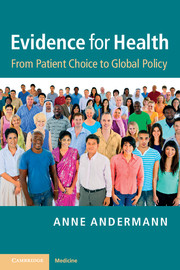Book contents
- Frontmatter
- Contents
- Foreword
- Preface
- Endorsements
- About the author
- Acknowledgments
- 1 Introduction
- 2 Strategies for improving health
- 3 Understanding how decisions influence health
- 4 Producing evidence to inform health decisions
- 5 Facilitators and barriers to using evidence
- 6 Making evidence-informed decisions
- 7 Conclusion
- Index
- References
5 - Facilitators and barriers to using evidence
Published online by Cambridge University Press: 05 February 2013
- Frontmatter
- Contents
- Foreword
- Preface
- Endorsements
- About the author
- Acknowledgments
- 1 Introduction
- 2 Strategies for improving health
- 3 Understanding how decisions influence health
- 4 Producing evidence to inform health decisions
- 5 Facilitators and barriers to using evidence
- 6 Making evidence-informed decisions
- 7 Conclusion
- Index
- References
Summary
Producing evidence is not the same as using evidence. Notwithstanding the value of creating knowledge for its own sake, it is difficult to justify spending valuable resources on countless research studies, especially research studies where there is potential for causing harm to research subjects (whether human or animal), if it does not contribute to a deeper understanding of the world we live in and how to make that world a better place. Yet, even the highest quality evidence is useless if it is not incorporated into decision-making for health. Indeed, the study of why health practitioners do not use evidence-based clinical practice guidelines has become a field of research in its own right. A systematic review of systematic reviews found that interactive techniques such as audit, feedback, outreach and reminder systems work best to promote the uptake of evidence. Despite this, clinical practice guidelines are often used in an attempt to change physician behaviours, but with much less success. There exists an entire online clearinghouse with thousands of such guidelines, but what good are they if nobody uses them? Therefore, at the core of the research cycle presented in the previous chapter, there is “synthesis, dissemination and utilisation”, which are the driving forces for ensuring that research evidence is used to influence decisions that can improve health. In an ideal world, this is not just an afterthought at the end of the cycle, but something that occurs every step of the way to continually move evidence into policy and practice (Fig. 5.1). However, if our goal is to make more evidence-informed decisions that improve health, it is also important to be aware of the many barriers to using research evidence, such as missing the window of opportunity, controversy over the research findings and vested interests. This chapter therefore describes in greater detail some of the facilitators and barriers to translating research evidence into improved health outcomes.
- Type
- Chapter
- Information
- Evidence for HealthFrom Patient Choice to Global Policy, pp. 121 - 145Publisher: Cambridge University PressPrint publication year: 2012



